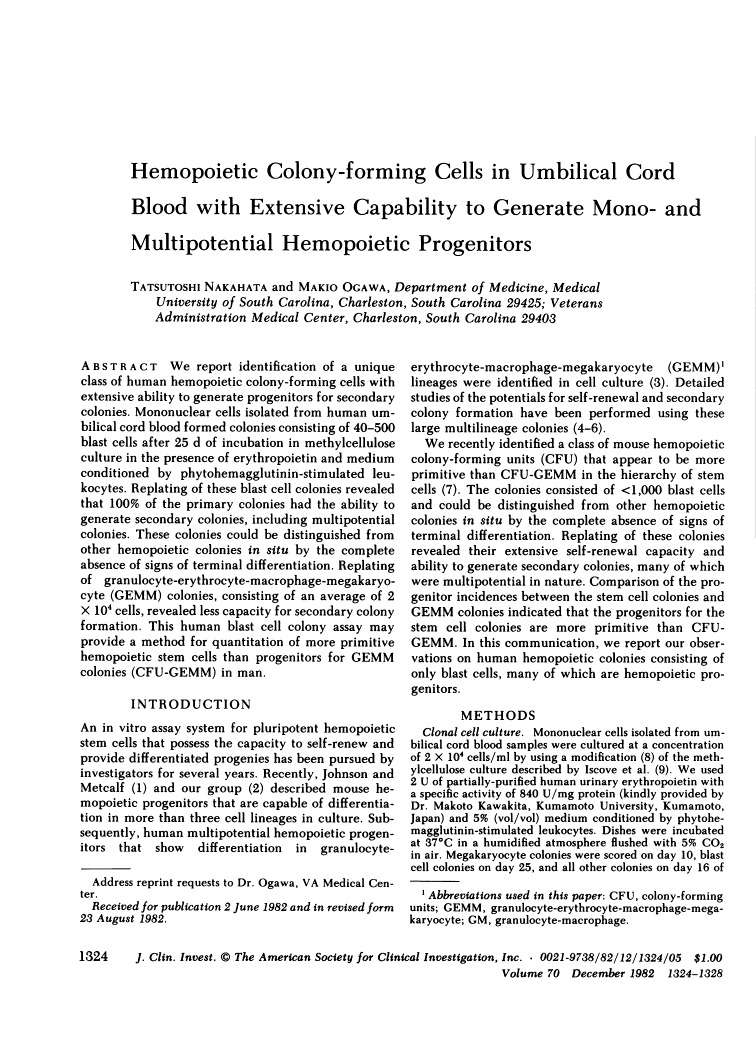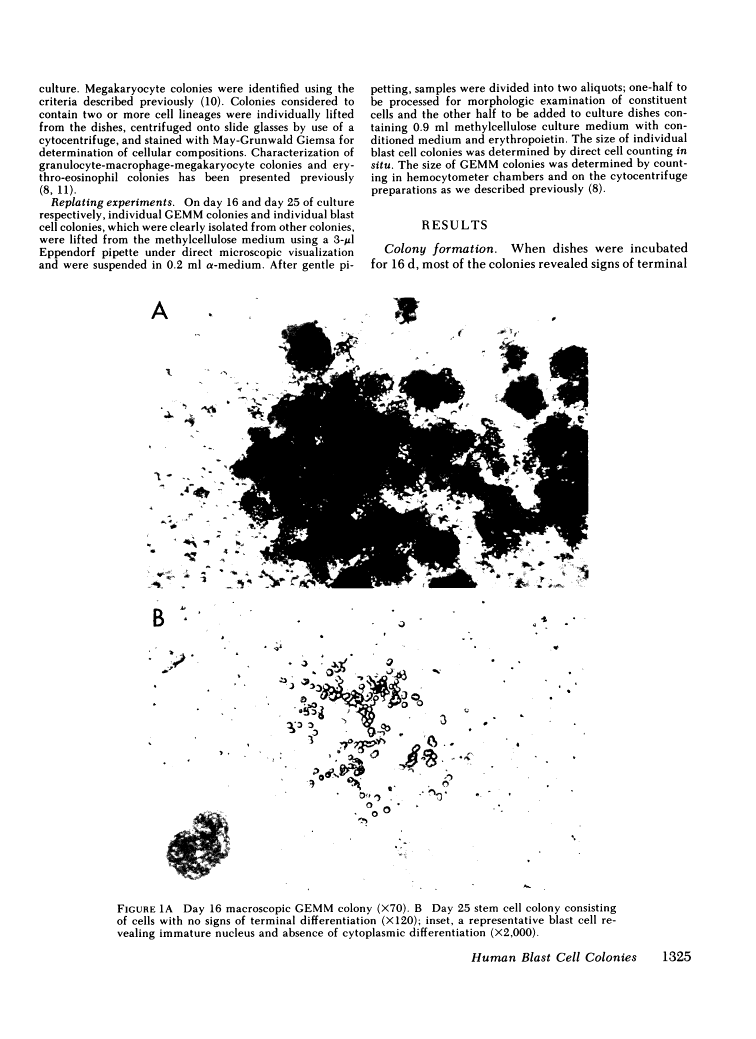Abstract
Free full text

Hemopoietic colony-forming cells in umbilical cord blood with extensive capability to generate mono- and multipotential hemopoietic progenitors.
Abstract
We report identification of a unique class of human hemopoietic colony-forming cells with extensive ability to generate progenitors for secondary colonies. Mononuclear cells isolated from human umbilical cord blood formed colonies consisting of 40-500 blast cells after 25 d of incubation in methylcellulose culture in the presence of erythropoietin and medium conditioned by phytohemagglutinin-stimulated leukocytes. Replating of these blast cell colonies revealed that 100% of the primary colonies had the ability to generate secondary colonies, including multipotential colonies. These colonies could be distinguished from other hemopoietic colonies in situ by the complete absence of signs of terminal differentiation. Replating of granulocyte-erythrocyte-macrophage-megakaryocyte (GEMM) colonies, consisting of an average of 2 x 10(4) cells, revealed less capacity for secondary colony formation. This human blast cell colony assay may provide a method for quantitation of more primitive hemopoietic stem cells than progenitors for GEMM colonies (CFU-GEMM) in man.
Full text
Full text is available as a scanned copy of the original print version. Get a printable copy (PDF file) of the complete article (970K), or click on a page image below to browse page by page. Links to PubMed are also available for Selected References.
Images in this article
Click on the image to see a larger version.
Selected References
These references are in PubMed. This may not be the complete list of references from this article.
- Johnson GR, Metcalf D. Pure and mixed erythroid colony formation in vitro stimulated by spleen conditioned medium with no detectable erythropoietin. Proc Natl Acad Sci U S A. 1977 Sep;74(9):3879–3882. [Europe PMC free article] [Abstract] [Google Scholar]
- Hara H, Ogawa M. Murine hemopoietic colonies in culture containing normoblasts, macrophages, and megakaryocytes. Am J Hematol. 1978;4(1):23–34. [Abstract] [Google Scholar]
- Fauser AA, Messner HA. Identification of megakaryocytes, macrophages, and eosinophils in colonies of human bone marrow containing neurtophilic granulocytes and erythroblasts. Blood. 1979 May;53(5):1023–1027. [Abstract] [Google Scholar]
- Johnson GR. Colony formation in agar by adult bone marrow multipotential hemopoietic cells. J Cell Physiol. 1980 Jun;103(3):371–383. [Abstract] [Google Scholar]
- Humphries RK, Eaves AC, Eaves CJ. Self-renewal of hemopoietic stem cells during mixed colony formation in vitro. Proc Natl Acad Sci U S A. 1981 Jun;78(6):3629–3633. [Europe PMC free article] [Abstract] [Google Scholar]
- Ash RC, Detrick DA, Zanjani ED. Studies of human pluripotential hemopoietic stem cells (CFU-GEMM) in vitro. Blood. 1981 Aug;58(2):309–316. [Abstract] [Google Scholar]
- Nakahata T, Ogawa M. Identification in culture of a class of hemopoietic colony-forming units with extensive capability to self-renew and generate multipotential hemopoietic colonies. Proc Natl Acad Sci U S A. 1982 Jun;79(12):3843–3847. [Europe PMC free article] [Abstract] [Google Scholar]
- Nakahata T, Spicer SS, Ogawa M. Clonal origin of human erythro-eosinophilic colonies in culture. Blood. 1982 Apr;59(4):857–864. [Abstract] [Google Scholar]
- Iscove NN, Sieber F, Winterhalter KH. Erythroid colony formation in cultures of mouse and human bone marrow: analysis of the requirement for erythropoietin by gel filtration and affinity chromatography on agarose-concanavalin A. J Cell Physiol. 1974 Apr;83(2):309–320. [Abstract] [Google Scholar]
- Messner HA, Jamal N, Izaguirre C. The growth of large megakaryocyte colonies from human bone marrow. J Cell Physiol Suppl. 1982;1:45–51. [Abstract] [Google Scholar]
- Nakahata T, Ogawa M. Clonal origin of murine hemopoietic colonies with apparent restriction to granuclocyte-macrophage-megakaryocyte (GMM) differentiation. J Cell Physiol. 1982 Jun;111(3):239–246. [Abstract] [Google Scholar]
- Messner HA, Izaquirre CA, Jamal N. Identification of T lymphocytes in human mixed hemopoietic colonies. Blood. 1981 Aug;58(2):402–405. [Abstract] [Google Scholar]
Associated Data
Articles from The Journal of Clinical Investigation are provided here courtesy of American Society for Clinical Investigation
Full text links
Read article at publisher's site: https://doi.org/10.1172/jci110734
Read article for free, from open access legal sources, via Unpaywall:
http://www.jci.org/articles/view/110734/files/pdf
Citations & impact
Impact metrics
Article citations
Allogeneic hematopoietic cell transplantation from alternative donors in acute myeloid leukemia.
Ann Hematol, 17 Aug 2024
Cited by: 0 articles | PMID: 39153145
Review
The universal stem cell.
Leukemia, 36(12):2784-2792, 28 Oct 2022
Cited by: 8 articles | PMID: 36307485 | PMCID: PMC9712109
Review Free full text in Europe PMC
Hypomorphic mutation of the mouse Huntington's disease gene orthologue.
PLoS Genet, 15(3):e1007765, 21 Mar 2019
Cited by: 10 articles | PMID: 30897080 | PMCID: PMC6445486
Mesenchymal stem cell therapy for neonatal intraventricular hemorrhage: a long way to go?
Ann Transl Med, 7(5):79, 01 Mar 2019
Cited by: 2 articles | PMID: 31019929 | PMCID: PMC6462639
Insights into Endothelial Progenitor Cells: Origin, Classification, Potentials, and Prospects.
Stem Cells Int, 2018:9847015, 18 Nov 2018
Cited by: 101 articles | PMID: 30581475 | PMCID: PMC6276490
Review Free full text in Europe PMC
Go to all (148) article citations
Similar Articles
To arrive at the top five similar articles we use a word-weighted algorithm to compare words from the Title and Abstract of each citation.
Identification in culture of a class of hemopoietic colony-forming units with extensive capability to self-renew and generate multipotential hemopoietic colonies.
Proc Natl Acad Sci U S A, 79(12):3843-3847, 01 Jun 1982
Cited by: 135 articles | PMID: 6954527 | PMCID: PMC346524
Mast cell growth factor (c-kit ligand) supports the growth of human multipotential progenitor cells with a high replating potential.
Blood, 78(9):2216-2221, 01 Nov 1991
Cited by: 64 articles | PMID: 1718490
Human multipotential progenitor cells (CFU-GEMM) have extensive replating capacity for secondary CFU-GEMM: an effect enhanced by cord blood plasma.
Blood, 81(4):942-949, 01 Feb 1993
Cited by: 52 articles | PMID: 7679010
Hemopoietic and lymphoid progenitor cells in human umbilical cord blood.
Dev Immunol, 4(1):1-11, 01 Jan 1994
Cited by: 7 articles | PMID: 7620322 | PMCID: PMC2275943
Review Free full text in Europe PMC
Funding
Funders who supported this work.
NHLBI NIH HHS (1)
Grant ID: HL20913
NIADDK NIH HHS (1)
Grant ID: AM22170











